
|
Sale 69
The May Pre-Long Beach Auction
| Hawaii Coins - Forsythe Collection |
| |
| |
| Lot |
Photo |
Description |
Realized |
Lot 1803 |
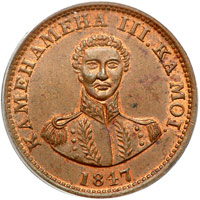 |
1847 Hawaiian Cent. . Medcalf-Russell 2CC-2. Crosslet 4, 15 berries 7 + 8. PCGS graded MS-64 Red & Brown CAC Approved. In a new secure plus holder. Pop 19; 2 finer, 1 in 64+, 1 in 65. About 20% mint red visible. Boldly struck. AUPUNI HAWAII (Kingdom of Hawaii). The denomination carries a misprint, since there is no "R" in the 12-letter Hawaiian alphabet, the engraver should have used the letter "L" as HANELI. Hapa Haneli would mean roughly translated, Half Hundred or the fraction 1/100. There are five varieties of number and arrangement of berries in the wreath of the cent, and two different obverses of King Kamehameha III (PCGS # 10966) .
Estimated Value $2,200 - 2,400.
The Forsythe Collection.
View details and enlarged photos
Check results on similar lots
| Realized
$5,520 |
Lot 1804 |
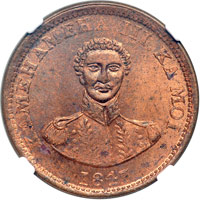 |
1847 Hawaiian Cent. NGC graded MS-64 Red & Brown. Over 50% of mint red. A very choice example. Crosslet or plain 4 refers to the numeral in the date. One 4 has a serif only at the bottom and is called "plain 4" while the other has an additional vertical serif on the horizontal bar and is referred to as "crosslet 4." Both varieties are the same size, one tilted slightly to the left. There are other minor differences. Pop 4; 1 finer in 65 (PCGS # 10966) .
Estimated Value $2,200 - 2,400.
The Forsythe Collection.
View details and enlarged photos
Check results on similar lots
| Realized
$3,105 |
Lot 1805 |
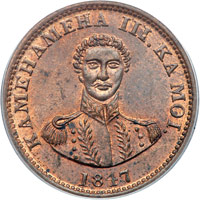 |
1847 Hawaiian Cent. . Medcalf-Russell 2CC-2. Crosslet 4, 15 berries 7 + 8. PCGS graded MS-64 Red & Brown CAC Approved. In a new secure plus holder. Pop 19; 2 finer, 1 in 64+, 1 in 65. About 30% mint red visible on this early coin from Hawaii. People sometimes ask, how did Hawaii conduct business with a coinage consisting only of copper coins. But the fact is, silver and gold coins of the world as they passed through this growing trade hub, were accepted for day to day transactions. It could have remained that way but for a later Monarch, David Kalakaua, who desired to promote his own stewardship as head of state by placing his effigy on the money (PCGS # 10966) .
Estimated Value $2,200 - 2,400.
The Forsythe Collection.
View details and enlarged photos
Check results on similar lots
| Realized
$2,645 |
Lot 1806 |
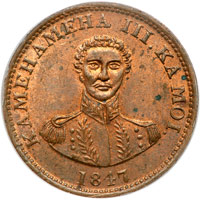 |
1847 Hawaiian Cent. . Medcalf-Russell 2CC-2. Crosslet 4, 15 berries 7 + 8. PCGS graded MS-63 Red & Brown CAC Approved. In a new secure plus holder. Pop 59; 22 finer, 1 in 63+, 19 in 64, 1 in 64+, 1 in 65. Some spots with about 25% mint red visible, a fine portrait of the King showing nicely formed nose (which is sometimes flattened on these since it represents the most exposed point on the obverse). Clear detail in the coat and epaulets. A choice example (PCGS # 10966) .
Estimated Value $1,800 - 2,000.
The Forsythe Collection.
View details and enlarged photos
Check results on similar lots
| Realized
$1,840 |
Lot 1807 |
 |
1847 Hawaiian Cent. . Medcalf-Russell 2CC-2. Crosslet 4, 15 berries 7 + 8. PCGS graded MS-63 Red & Brown CAC Approved. In a new secure plus holder. Pop 59; 22 finer, 1 in 63+, 19 in 64, 1 in 64+, 1 in 65. Some spots with over 30% mint red. Very unusual it is to find a Hawaiian Cent with this amount of red mint color, collectors are expected to be active bidders in the sale, so prepare bids accordingly (PCGS # 10966) .
Estimated Value $1,800 - 2,000.
The Forsythe Collection.
View details and enlarged photos
Check results on similar lots
| Realized
$2,990 |
Lot 1808 |
 |
1847 Hawaiian Cent. . Medcalf-Russell 2CC-2. Crosslet 4, 15 berries 7 + 8. PCGS graded MS-62 Brown CAC Approved. In a new secure plus holder. A nice brown example with luster gloss throughout and plenty of eye-appeal. Kamehameha III ruled 1824-54. Approximately 100,000 One-cent pieces were struck during his reign at (presumably) a New England firm. As of an 1862 Hawaiian Treasury audit, only 11,595 remained outstanding. Scarce in all grades (PCGS # 10965) .
Estimated Value $1,300 - 1,400.
The Forsythe Collection.
View details and enlarged photos
Check results on similar lots
| Realized
$1,380 |
Lot 1809 |
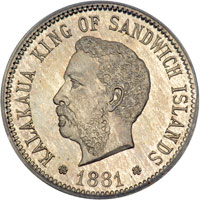 |
1881 Hawaiian Pattern Five Cents. PCGS graded MS-66 CAC Approved. In a new secure plus holder. Pop 2; none finer at PCGS. Nice light even toning. Tied for the finest known. Intense but still satiny frost, the coin lightly toned to a quiet soft golden color through which nickel-gray luminosity persists almost undiminished. Something perhaps worth adding to the smooth finish is how desirable this coin is with this precision strike at Kalakaua�s profile as well as throughout the unusual reverse which portrays a royal garter of the Kingdom inscribed AU MAU KE EA O KA AINA I KA PONO. A small cross attached to the crown distinguishes this from the later-made, unofficial strikes. All patterns by this minter are on a thin nickel planchet. No Proofs recorded.
Donald Medcalf offers a succinct description of this coin�s issue: "In 1881 King Kalakaua made an historic trip around the world while his new palace was being built. He was the first world Monarch to have journeyed the globe. During his travels, the owner of a New Caledonia nickel mine was able to contact the king and offered to have nickel coins struck for the Kingdom of Hawaii. Approximately 200 nickel patterns with the king�s effigy on the obverse were minted in Paris and sent to the king after he had returned to Hawaii. No proofs were ever struck, and the coin was never officially adopted. Many of the coins became "pocket pieces" or were fashioned into jewelry."
Also of note, but we are unable to discern the presence of this due to the PCGS holder�s restraining collar, "Some edge-marked in incuse with indistinct imprint: "MAILLECHORT," explains the same author. [Note: French for nickel silver from the names of two Lyon craftsmen who invented it Maill(ot) and Chor(ier). A hard, corrosion-resistant alloy of copper, zinc and nickel used to make domestic silverware. Also known as German silver.] (PCGS # 10975) .
Estimated Value $30,000 - 35,000.
The Forsythe Collection.
View details and enlarged photos
Check results on similar lots
| Realized
$41,400 |
Lot 1810 |
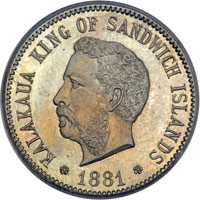 |
1881 Hawaiian Pattern Five Cents. PCGS graded MS-66 CAC Approved. In a new secure plus holder. Pop 2; none finer at PCGS. Lovely light even toning. Tied for the finest known. A very scarce issue of which only 200 pieces were struck. This is the desirable original specimen struck by a New Caledonia nickel miner in 1881. It is tied for Finest Certified and is not one of the later strikes from different dies made, some believe, in the early years of the 20th century. The coin offered exhibits a cross on top of the crown on the reverse, which is diagnostic. Smooth rolling-fresh finish, fresh as when first issued barring, of course, some natural light patina from one hundred thirty-one years storage! Difficult to find in any grade now, but especially elusive in Gem condition. So much for the luster which is a key determinant of grade. It appears to us that all minute detail is fully evident on this bold specimen, another item that has long played a major role in a coin�s desirability. This MS66 is for the specialist in the series; it�s rarity and high quality preclude all but the most well-heeled numismatist from bidding, sadly. Had you been collecting coins in the 1940s or 1950s, Hawaiian Five Cent pieces, while not cheap, would have been more affordable when there were far fewer collectors and astute rare coin investors around (PCGS # 10975) .
Estimated Value $30,000 - 35,000.
The Forsythe Collection.
View details and enlarged photos
Check results on similar lots
| Realized
$39,100 |
Lot 1811 |
 |
1881 Hawaiian Pattern Five Cents. . Medcalf-Russell 2CN-1. PCGS graded MS-65 CAC Approved. In a new secure plus holder. Pop 2; 2 finer in 66. Light even toning. A heart-stopping gem of the premium quality one likes to see for this actively collected series from America�s 50th State. This is the only state in the Union that preceded Statehood as a Kingdom, then a Republic, and finally a Territory. The low census at this grade level indicates quite strongly just how rare these are in Gem quality! A beaming gem rolling in unbeatable subdued luster characteristic of the hard nickel alloy, yet luster that emits boldly beneath bold highlights. Possessed of a much better-quality strike than is found on some others in lesser grade, all of the King�s hair curls and beard detail show plainly, all of the accompanying detail on the garter, garter clasp, and crown similarly impressive.
In 1881, the King of Hawaii became the first Monarch in history to travel around the world. Earlier key figures like Alexander the Great and the Emperor Hadrian in the ancient world traveled around their extensive domains, but neither could have imagined being a globe-trotter, which is what Kalakaua was! Among the nations he visited in his East to West circumnavigation were the United States (going first to San Francisco), Japan, China, India, Egypt, Italy, Belgium, Germany, Austria, France, Spain, and Great Britain and the United States (for a second visit). He had several objectives on this tour, one of the main ones being to encourage immigration to Hawaii, which was in an agricultural stage of development. The local population was too small to support the sugar and pineapple planters, and so migrant workers were the obvious choice, especially for Hawaii�s burgeoning sugar cane industry.
When in Paris, the owner of a New Caledonia nickel mine approached Kalakaua for a nickel contract. As encouragement, the miner had struck some sample German-silver five kenata patterns using nickel from his mine. The die engraver made a slight error when he misspelled the first word of Hawaii�s national motto "UA MAU KE EA O KA AINA I KA PONO" This motto overlaps the garter on the reverse of the coin and on top of which is a crown decorated with a small cross. (The rarity of the 1881 patterns, according to Medcalf, led to a circa-1900 Canadian copy, identified by a small ball atop the crown in place of the cross) (PCGS # 10975) .
Estimated Value $25,000 - 30,000.
The Forsythe Collection.
View details and enlarged photos
Check results on similar lots
| Unsold |
Lot 1812 |
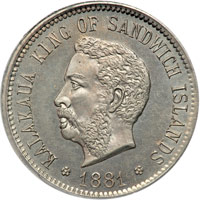 |
1881 Hawaiian Pattern Five Cents. . Medcalf-Russell 2CN-1. PCGS graded MS-64 CAC Approved. In a new secure plus holder. Pop 6; 5 finer, 1 in 64+, 2 in 65, 2 in 66. Lovely light golden toning. Swirling cartwheel luster blends naturally with pale golden highlights on the satin surfaces. King Kalakaua�s bust faces left (on the similar silver issues of 1883, the bust faces right). The obverse legend contains an unintentionally insulting blunder, referring to Kalakaua as the KING OF SANDWICH ISLANDS instead of Hawaii. The Sandwich Islands was the European name for Hawaii and so-named for the British Earls of Sandwich. Sandwich Islands was the name given to the Hawaiian Islands by James Cook in the 1770s, which explains the origin of the now archaic usage.
In all, 200 1881 patterns were struck. Few were acquired by numismatists, hence their rarity in choice to gem condition. According to Medcalf, "many of the coins became pocket pieces or were fashioned into jewelry."
The present MS64 specimen provides a major gift for the Hawaiian rarities collector. An exemplary coin, it still exhibits beaming luster under medium golden-gray toning. The surfaces are outstanding (PCGS # 10975) .
Estimated Value $20,000 - 25,000.
The Forsythe Collection.
View details and enlarged photos
Check results on similar lots
| Unsold |
Lot 1813 |
 |
1881 Hawaiian Five Cents NGC graded Unc Details. Reverse scratched. A few obverse spots and some small pin scratches at 1:00 on the reverse. A scarce red book coin. Struck by a private minter at the time of King Kalakaua's trip around the world in 1881. Scarce in all grades. The state motto on the reverse AU MAU KE EA O KA AINA I KA PONO has the letters accidentally reversed on the first word, which should be "UA". Approximately 200 five-cent patterns with the King's effigy on the obverse were coined in Paris. Some of these are found circulated. Others were soldered together into napkin rings, thereby lessening the number of acceptable numismatic examples (PCGS # 10975) .
Estimated Value $5,000 - 6,000.
The Forsythe Collection.
View details and enlarged photos
Check results on similar lots
| Realized
$11,100 |
Lot 1814 |
 |
1881 Hawaiian Five Cents. PCGS graded Proof 63 Deep Cameo. On the holder Hawaii (fantasy) strike. Double thickness. As with other non-standard coins in the Hawaiian series, the Proof strikes of the Kalakaua five-cent piece are knock-offs of the "original" private-issue Mint States struck to temp King Kalakaua into issuing him a contract for coinage. The original five-cent pieces are struck on a thin planchet and are only found up to Mint State. No Proofs are known. Five cent pieces similar in design to the original Hawaiian 1881 five-cent nickel piece were struck in thin and thick nickel (1.4 and 2.7 mm), thin and thick aluminum (1.42 and 3.1 mm) and thin copper (1.7 mm), all in Proof. According to Medcalf, in whose Standard Catalog of Hawaiian Coins readers who wish to do so will find more details, these were "struck from different dies [than the originals] … they can be easily distinguished by absence of a cross on top of the crown. These were not official, or struck in 1881." But again, for decades now they have been avidly sought and collected by specialists in Hawaiian numismatics right along with the rest. A choice, impressive glittering Proof struck in aluminum. PCGS # 510976.
Estimated Value $1,500-UP.
The Forsythe Collection.
View details and enlarged photos
| Realized
$5,060 |
Lot 1815 |
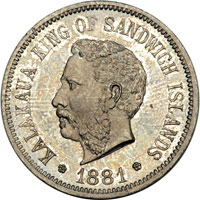 |
1881 Hawaiian Five Cent Struck In Nickel 7.6 Grams. PCGS graded Proof 64. On the holder Hawaii (fantasy) strike. Another of the thick planchet strikes of this venerable type which collectors and students of Hawaiian numismatics have discussed for years without coming to an agreement. For more than a century collectors have been fascinated by these Proof nickel and aluminum strike Five Cent pieces. They were believed to have been struck shortly after the turn of the 20th century. Some accounts point to a private minter in Canada. PCGS # 510974.
Estimated Value $1,500-UP.
The Forsythe Collection.
View details and enlarged photos
| Unsold |
Lot 1816 |
 |
1881 Hawaiian Pattern Five Cent Struck In Aluminum 1.5 Grams. PCGS graded Proof 64+ Deep Cameo. On the holder Hawaii (fantasy) stike. Similar to the thick planchet example and also a gleaming, well made Proof. From dies similar to the Medcalf-Russell 2CN-1 pieces, but missing the cross on top of the crown (diagnostic). PCGS # 510976.
Estimated Value $1,500-UP.
The Forsythe Collection.
View details and enlarged photos
| Realized
$5,060 |
Lot 1817 |
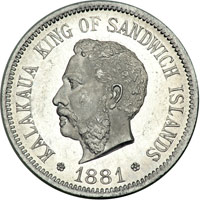 |
1881 Hawaiian Five Cent Struck In Aluminum 1.5 Grams. PCGS graded Proof 64 Deep Cameo. On the holder Hawaii (fantasy) strike. Flaw on rim at 6:00, well struck otherwise and identifiable as to type by the Proof surface and the absence of a cross at the top of the crown. PCGS # 510976.
Estimated Value $1,500-UP.
The Forsythe Collection.
View details and enlarged photos
| Unsold |
Lot 1818 |
 |
1883 Hawaiian Ten Cents. PCGS graded Proof 66 Cameo CAC Approved. In a new secure plus holder. Pop 1; none finer at PCGS. Wonderful blue toning on both sides. Probably the finest known.
From the Stack�s 2008 description: "Bare head r. of Kalakaua I, surrounded by the English title King of Hawaii. Reverse presents the Kingdom's motto, UA MAU KE EA OKA AINA I KA PONO, The Life of the Land is Perpetuated in Righteousness around a laurel wreath enclosing the English denomination ONE/ DIME. The Hawaiian denomination UMI KENETA, 10 Cents appears below the wreath tie. Deep liquid-glass fields boast rich electric blue and pale russet-gold toning near the crisply defined rims enhancing the overwhelming beauty of this breathtaking Gem.
"This splendid coin is one of only 26 Proofs struck. The dime is the second rarest of all Hawaiian Proof denominations as a business strike and the present example ranks at the top among the few Proof examples available to collectors in the 21st century." It is significant that this is the finest certified PCGS has assigned no grade higher than a single example at Proof-66. The Dannreuther-Garrett auction record book shows the highest grade appearing at auction in recent years to be the Proof-63 in the 2007 FUN Sale. Future editions of Dannreuther will undoubtedly include this particular Proof 66 along with the pedigree stewardship of the new owner. Bidders may want to take note.
The present glittering jewel is a compelling coin that invites the most careful attention. Few numismatists are fortunate enough to have their name associated with a great coin like this.
(Originally part of a five-piece 1883 Hawaiian silver Proof set that appears to have been kept intact since the time of striking. The other coins from this set are offered singly in the Gerald Forsythe consignment.).
Estimated Value $20,000 - 25,000.
The Forsythe Collection. Previously Stack's 11/2008.
View details and enlarged photos
| Realized
$34,500 |
Lot 1819 |
 |
1883 Hawaiian Ten Cents. . Medcalf-Russell 2CS-1. PCGS graded Proof 66 CAC Approved. In a new secure plus holder. Pop 3; none finer at PCGS. Nicely toned on both sides with delicate shades of origiinal color which include warm golds to amber deep trending into red, along with subtle antique grays blending effortlessly across the surface into iridescent silvery and blue. (The companion Proof 66 to this dime in the accompanying Lot has toning at the edge but not suffused throughout the field on either side like this specimen.)
An apt term for the surface would be "resplendent fields," since the fields below the toning are as smooth, level to perfection, and gleaming with reflectivity as when first struck. Probably a good many Hawaiian coins are no longer as carefully preserved as this magnificent Proof piece, with no suggestion or even a whisper of weakness at the King�s sideburn, hair curls, or mutton-chop beard. Even under strong magnification, the detail delights the connoisseur�s eye.
The Hawaiian Dime, unlike its larger cousins, skips the royal emblem on the reverse and is instead modeled along the lines of the U.S. Seated Liberty dimes of the day, with an open wreath in which is placed the denomination. A small royal crown above. The national motto which surrounds was adopted in the 1840s for the Kingdom of Hawaii and carried over into the 20th Century as the official Hawaii State motto when Hawaii became the 50th State in the Union in 1959.
Proofs were struck at the Philadelphia Mint along with the other 1883 Kalakaua Proof coinage, from dies made under the stewardship of Charles E. Barber, chief engraver of the Mint. These, like the quarter dollar, half dollar, and silver dollar use the standard weight and fineness of American coins. U.S. coins were legal tender in the Hawaiian Islands from an early period.
An impressive rarity in the Hawaiian series. This splendid coin is one of only 26 Proofs struck. More to the point, the dime is the second rarest of all Hawaiian Proof denominations as a business strike and the present example ranks at the top among the few Proof examples available to collectors in the 21st century. It is significant that this is tied with two others as finest certified PCGS and that PCGS has assigned no grade higher than Proof-66.
A coin that will fascinate and bring chills down the spin of any numismatist who spends a few minutes with it, and we can see how this may well bring a record-shattering price for a Hawaiian Ten Cent piece! (PCGS # 10981) .
Historic note: Hawaii's second elected ruler, David Kalakaua came to the throne in 1874 after the premature death of King William Lunalilo (who died from tuberculosis at the age of 39). Kalakaua is responsible for restoring Hawaiian culture, hobbled for decades by Christian missionaries, for building Iolani Palace, and, in an effort to promote his kingdom in America, Europe, and the Far East. King Kalakaua became the first monarch to circumnavigate the globe.
Estimated Value $20,000 - 25,000.
The Forsythe Collection.
View details and enlarged photos
Check results on similar lots
| Realized
$29,900 |
Lot 1820 |
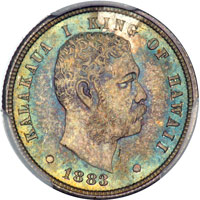 |
1883 Hawaiian Ten Cents. PCGS graded MS-66 CAC Approved. In a new secure plus holder. Pop 11; 1 finer in 67. Beautiful green toning atop lustrous fields that glow with mint-original vibrancy. We have rarely seen a poorly struck Hawaiian dime. The San Francisco Mint (which struck these) did a first-rate job on the dimes, most quarters, half dollars and silver dollars. Among the key characteristics, the coin displays clear-cut portrait, wreath and crown, as well as all legends and rim denticles from having been giving a full strike by the dies (PCGS # 10979) .
Estimated Value $2,500 - 2,800.
The Forsythe Collection.
View details and enlarged photos
Check results on similar lots
| Realized
$4,600 |
Lot 1821 |
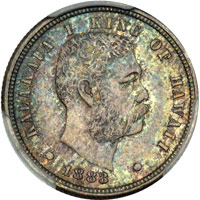 |
1883 Hawaiian Ten Cents. PCGS graded MS-66. In a new secure plus holder. Pop 11; 1 finer in 67. Well struck and nicely toned. The powerfully struck, lustrous surfaces are readily appreciable at all angles to which the toning adds another level of beauty. This is an important issue among buyers of Gem quality Hawaiian coins. No one can honestly deny the vibrancy of the surfaces, which shows in the fully struck devices exhibiting fine detail to all the high points (PCGS # 10979) .
Estimated Value $2,500 - 2,800.
The Forsythe Collection.
View details and enlarged photos
Check results on similar lots
| Realized
$5,808 |
Lot 1822 |
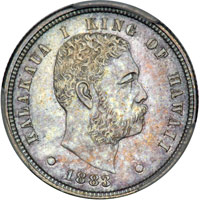 |
1883 Hawaiian Ten Cents. PCGS graded MS-65 CAC Approved. In a new secure plus holder. Pop 20; 12 finer, 11 in 66, 1 in 67. Subtle multi-dimensional tones grace the obverse. The reverse exhibits similar shades with a greater intensity. A first-rate Gem! (PCGS # 10979) .
Estimated Value $2,200 - 2,400.
The Forsythe Collection.
View details and enlarged photos
Check results on similar lots
| Realized
$3,795 |
Lot 1823 |
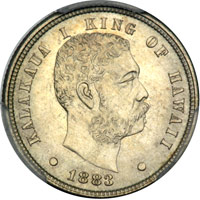 |
1883 Hawaiian Ten Cents. PCGS graded MS-65 CAC Approved. In a new secure plus holder. Pop 20; 12 finer, 11 in 66, 1 in 67. A hint of light tone. What is most noticeable when one first examines this Hawaiian dime is its satiny mint luster -- it swirls from side-to-side unimpeded by noticeable abrasions and unscathed by even a hint of tarnish, just pale toning. A coin of singular beauty and importance to the Hawaiiana collector. In such circumstances, the luster cannot stand alone. Desirable also is to see that this coin is struck with meticulous care by the dies on the wreath and small reverse crown as well as on Kalakaua�s hair, sideburn, and beard. Everything razor-sharp (PCGS # 10979) .
Estimated Value $2,200 - 2,400.
The Forsythe Collection.
View details and enlarged photos
Check results on similar lots
| Realized
$3,680 |
Lot 1824 |
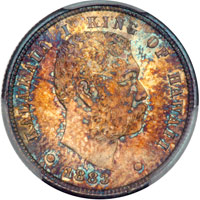 |
1883 Hawaiian Ten Cents. PCGS graded MS-65. In a new secure plus holder. Pop 20; 12 finer, 11 in 66, 1 in 67. Wonderful blue and golden toning. A glowing lustrous originality is emitted from undisturbed toned surfaces. As far as the strike goes, putting the results in a few words we can say it was struck with systematic exactness throughout (PCGS # 10979) .
Estimated Value $2,200 - 2,400.
The Forsythe Collection.
View details and enlarged photos
Check results on similar lots
| Realized
$3,462 |
Lot 1825 |
 |
1883 Hawaiian Ten Cents. PCGS graded MS-64 CAC Approved. In a new secure plus holder. Pop 34; 32 finer, 20 in 65, 11 in 66, 1 in 67. Lovely light golden toning on both sides. The obverse displays prooflike surfaces (PCGS # 10979) .
Estimated Value $2,000 - 2,200.
The Forsythe Collection.
View details and enlarged photos
Check results on similar lots
| Realized
$2,760 |
Lot 1826 |
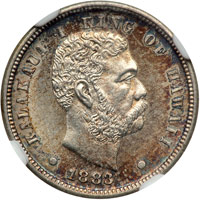 |
1883 Hawaiian Ten Cents. NGC graded MS-64. Light hint of gold tone. Well struck, lustrous. Pop 27; 23 finer (PCGS # 10979) .
Estimated Value $2,000 - 2,200.
The Forsythe Collection.
View details and enlarged photos
Check results on similar lots
| Realized
$1,955 |
Lot 1827 |
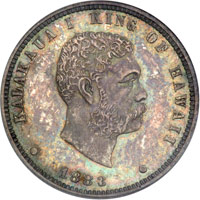 |
1883 Hawaiian Eighth Dollar. PCGS graded Proof 66 CAC Approved. In a new secure plus holder. Pop 2; none finer at PCGS. Probably the finest known. Bare head r. of Hawaii's last King matches that appearing on the other 1883 silver coins. The reverse bears the Hawaiian denomination HAPAWALU in a laurel wreath, the English equivalent below, EIGHTH DOL. with royal motto as legend, The Life of the Country is Perpetuated in Righteousness. Magnificent deeply gleaming silver contrasts with fascinating dappled toning for outstanding visual appeal.
One of only 20 Proofs struck from a single pair of dies and included in Proof sets made for presentation to Hawaiian notables, further limiting distribution. This seemingly odd denomination was first specified because it was equal to the old Spanish Real valued at 12½ cents that had long circulated in the islands. However, when regular coinage began, the dime was substituted, since the San Francisco Mint already had dime planchets on hand whose use would reduce the cost of the coinage. The 10-cent denomination was also part of the American decimal system of dime, quarter, half dollar and dollar.
No Hapawalu coins were struck for circulation, intensifying collector pressure on the few Proofs, which have been eagerly sought by collectors for 125 years. This Proof denomination is very seldom encountered at auction. The present coin's auction appearance provides an historic opportunity for collectors of the finest Hawaiian coins, a chance that may not occur again in the foreseeable future.
In their request to have coins struck by the United States government, the Hawaiian government included four denominations: a 1/8th Dollar (Hapawalu), a 1/4 Dollar (Hapaha), a 1/2 Dollar (Hapalua), and a Dollar (Akahi Dala). All of the denominations, except the 1/8th Dollar, conformed to American coins in size, weight and value. Because the Hapawalu would have required specially made blanks, a Dime denomination (Umi Keneta) was substituted for the Hapawalu. No Hapawalus were struck for circulation, but when 20 special presentation Proof sets were made at the Philadelphia Mint in 1884, Hapawalus were included along with the other four denominations.
(The Philadelphia Mint also produced 18 Hapawalus in copper from the same Proof dies and included them in four-piece Pattern sets of 12½c, 25c, 50c, and $1.) (PCGS # 10985) .
Estimated Value $60,000 - 70,000.
The Forsythe Collection.
View details and enlarged photos
Check results on similar lots
| Unsold |
Lot 1828 |
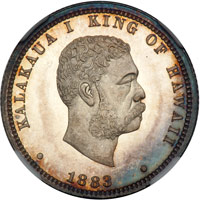 |
1883 Hawaiian Quarter Dollar. NGC graded Proof 66 Ultra Cameo. Star. Probably the finest known. A hint of tone on the edges. From the Stack�s 2008 description: "Flashing mirror silver surfaces are variegated by narrow bands of russet-blue at the outer rims of this example of a total Proof mintage of only 26 pieces. Careful study under high magnification reveals two delicate raised lines within the lower loop of the first 8. The reverse displays the crowned shield of Hawaii without supporters or mantle, flanked by ¼ - D, a design that neatly adapts itself to this relatively small planchet. Besides its absolute rarity, the present Gem represent an important condition rarity, as Proof-61 and Proof-62 are the highest grades recently appearing at auction according to the Dannreuther-Garrett auction compilation. This is the finest specimen graded by NGC. PCGS has assigned Proof-66 only once and has given no Hawaiian quarter any higher grade.
"This mouth-watering Cameo Gem Proof is another Hawaiian coin that will appeal to the seeker of the ultimate quality, and is among the finest known of this denomination today."
The present nearly superb Proof is a forceful coin that should tempt even the most hardened skeptic and expert in the series.
(Originally part of a five-piece 1883 Hawaiian silver Proof set that appears to have been kept intact since the time of striking. The other coins from this set are offered singly in the Gerald Forsythe consignment.) Pop 1; none finer at NGC .
Estimated Value $20,000 - 25,000.
The Forsythe Collection.
View details and enlarged photos
| Realized
$40,250 |
Lot 1829 |
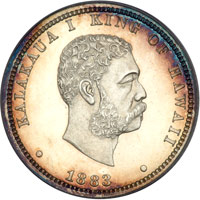 |
1883 Hawaiian Quarter Dollar. PCGS graded Proof 63 Cameo CAC Approved. In a new secure plus holder. Pop 1; 1 finer in 65. Lovely gold and blue toning on the rims. A small obverse mark is noticeable to the left of the date. The 1883 Kingdom of Hawaii coinage dies were engraved by noted Philadelphia Mint specialist Charles E. Barber who had a hand in making many of, if not most of the Proof U.S. coins that were struck in those days. His talent went into the engraving and manufacture of the dies that struck this fascinatingly beautiful series of Hawaiian silver coins minted in 1883 and distributed into circulation in the Islands beginning in January 1884. Initially, in September of 1883, six Proof sets were struck which included the quarter (Hapaha); a year later, an additional 20 sets were sent to the Hawaiian government using the same dies. These sets were issued for presentation to dignitaries in the Islands and were never offered for public sale (unlike regular U.S. Proof sets of 1883). This example exhibits deep and watery mirrored surfaces on both sides with frosted devices prominently creating a cameo-like effect as the coin is tilted gently under a light. Both sides are beautifully toned in shades of deep amber and a shade approaching cobalt blue at the rims. Very attractive, one might almost say mesmerizing when one takes into account the extreme rarity of choice quality Proof Hawaiian coins. The remaining surface is pretty much left free of color. Conservatively graded, this specimen will afford the next owner hours of enjoyment as a prime example of late-Kingdom Hawaiiana. (PCGS #810989).
Historic note: According to Medcalf in his definitive guide "Hawaiian Money Standard Catalog" second edition, "Hawaiian coins are of the same weight and fineness as their U.S. counterparts. After striking the required number of coins, obverse dies were defaced and are now stored in the State Archives of Hawaii in Honolulu." For those who would like to see what these dies look like, Medcalf kindly supplies photographs of them on page 39 of his book. He goes on to note, "Hubs, from which the dies were made, are preserved ath the Philadelphia Mint."
Estimated Value $13,000 - 15,000.
The Forsythe Collection; ex: Edwards H. Metcalf Lot #1217 Feb 1976 Superior Sale; Ron Russell; The 9/09 Hawaii Collection.
View details and enlarged photos
| Realized
$16,100 |
Lot 1830 |
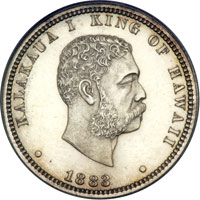 |
1883 Hawaiian Quarter Dollar. PCGS graded Proof 62 Cameo CAC Approved. In a new secure plus holder. Pop 2; 2 finer, 1 in 63, 1 in 65. Fully untoned with a tiny obverse scratch near the chin. A worthwhile Proof by any standard, the mirror reflection is not in the least disturbed by harsh toning or yielding to spots or other deterioration, while silvery colors blossom on both sides. The strike is confident, this being a typically well-made Proof of the period struck on the Philadelphia Mint�s most modern equipment; indeed, as bold as ever seen on virtually any coin of this period, Hawaiian or American. 1883 Hawaiian quarters in Proof format are rare, with very few in existence today. Only 26 were made. (PCGS #810989).
Associated with every coin ever issued is a story. Sometimes the story is lost or forgotten, but fortunately, the history of Hawaiian coins, the Proofs as well as the circulation strikes, is clearly recorded. Much of the documentary evidence lies in the Hawaii State Archives in Honolulu, a nondescript building lying under a large banyan tree behind Iolani Royal Palace. Tens of thousands of tourists visit Iolani Palace every year, but how many realize the Real History of Hawaii lies just a few steps away across the parking lot in that plain one-story building! At the time the Hawaiian silver was being proposed and struck, there was a controversy brewing. The King's silver directed attention to the coinage and currency problems of the Kingdom. One important result was the Gold Law of 1884, signed on July 17 (even before the silver coins arrived in the islands for distribution). Claus Spreckles, as agent for the government to the U.S. Mint, and the Kalakaua government itself, at first opposed this new law. The conservative businessmen of the community, including the Chamber of Commerce and those who opposed the coinage, supported it. According to Adler, "Essentially the argument was one of easy money versus hard money. The cry of the supporters of the gold law was: "Gold is the only currency." -- If this sounds familiar to numismatic historians reading this it is becasue the same controversy was taking place at the highest levels in the United States at the time.
Estimated Value $12,000 - 14,000.
The Forsythe Collection.
View details and enlarged photos
| Realized
$9,775 |
Lot 1831 |
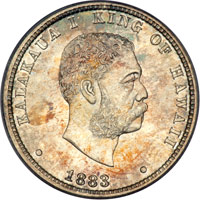 |
1883 Hawaiian Quarter Dollar. PCGS graded MS-67 CAC Approved. In a new secure plus holder. Pop 12; none finer at PCGS. A hint of light gold tone. Tied for finest graded. A lustrous Superb Gem that has icy white luster glinting through the delicate overlay of color and a remarkable crisp strike. Given the proper amount of strike pressure, the coin is fully brought up by the dies. We see no reason to add in any "howevers" or "if onlys" here, since there are no soft areas as are so often seen on this issue, none whatsoever! (PCGS # 10987) .
Before the reign of Kalakaua (1874-91) little had been done about a national coinage for the Kingdom of Hawaii. In 1847, the government issued a thousand dollars' worth of copper cents bearing the likeness of Kamehameha III. But that was all. The Kingdom's business was done using foreign coins of silver and gold, with (as the decades wore on) American money coming to dominate. (By 1884, the Hawaiian government went on a gold standard with the U.S. $20 gold piece being the standard against which all values were priced.
Estimated Value $2,000 - 2,500.
The Forsythe Collection.
View details and enlarged photos
Check results on similar lots
| Realized
$8,625 |
Lot 1832 |
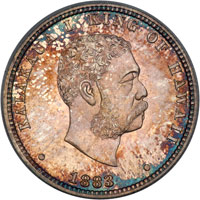 |
1883 Hawaiian Quarter Dollar. PCGS graded MS-67 CAC Approved. In a new secure plus holder. Pop 12; none finer at PCGS. Wonderful golden obverse toning. tied for finest graded. With four official denominations of Hawaiian silver coinage, the quarter dollar is the most affordable in top condition. All were made at the San Francisco Mint this year from dies prepared at the Philadelphia Mint by engraver Charles E. Barber (whose Barber coinage is familiar to collectors.) Production of $1 million in silver comprised greater quantities than was necessary for the island kingdom whose population at the time was under 100,000. A savvy west coast banker and sugar producer named Claus Spreckels (Spreckels sugar) held unofficial power in the Kalakaua government as a political insider. His influence on the King eventually prompted a contract with the United States Mint to produce the 1883 Hawaiian coinage. The incredible example offered here is among the elite, superb few Mint State 67 survivors we have been privileged to offer. Both sides display unrestrained frosty luster. Both sides are overlaid with delicate golden color. The strike is exactly as you'd expect: well executed and only the most inconsequential disturbances can be detected under close scrutiny (PCGS # 10987) .
Estimated Value $2,000 - 2,500.
The Forsythe Collection.
View details and enlarged photos
Check results on similar lots
| Realized
$8,625 |
Lot 1833 |
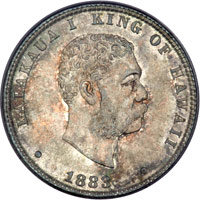 |
1883 Hawaiian Quarter Dollar. PCGS graded MS-66 CAC Approved. In a new secure plus holder. Pop 84; 13 finer, 1 in 66+, 12 in 67. Well struck and nicely toned. A highly impressive gem with a nuance of silvery sparkle striking through the toning on both sides, all of which is underpinned by smooth satin freshness. Struck from typically-sharp dies that imported all the fine detail and texture, especially at the key centers (PCGS # 10987) .
Estimated Value $700 - 800.
The Forsythe Collection.
View details and enlarged photos
Check results on similar lots
| Unsold |
Lot 1834 |
 |
1883 Hawaiian Quarter Dollar. PCGS graded MS-66 CAC Approved. In a new secure plus holder. Pop 84; 13 finer, 1 in 66, 12 in 67. Lovely shades of toning on both sides (PCGS # 10987) .
Historic note: Conception, approval, funding and creation of these handsome Hawaiian silver coins occurred in 1883-84. Though dated 1883, they first were placed into circulation in early 1884. All circulation-strike Hawaiian coinage was executed at the San Francisco Mint. The Bureau of the Mint instructed the Philadelphia Mint to send twenty pairs of dies (five sets for each of four coins) to E. F. Burton, Superintendent of the San Francisco Mint. Burton also got instructions that no coins were to be struck until a contract with the Hawaiian agent for the Kingdom, Claus Spreckles had been drawn up and approved. So the dies were made before the contract was approved, which seems curious to modern business methods. The contract, when it was approved on October 29, 1883, provided for $500,000 in dollars, $300,000 in halves, $125,000 in quarters and $75,000 in dimes, for a grand total of $1 million. Spreckles was to furnish silver bullion and to pay $17,500 for the actual minting. He had already paid $2,000 for design of the dies and $200 for twenty pairs of working dies, according to historian Jacob Adler, in his monograph "Coinage of Hawaii".
Estimated Value $700 - 800.
The Forsythe Collection.
View details and enlarged photos
Check results on similar lots
| Unsold |
Lot 1835 |
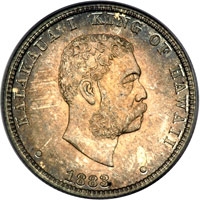 |
1883 Hawaiian Quarter Dollar. PCGS graded MS-66 CAC Approved. In a new secure plus holder. Pop 84; 13 finer, 1 in 66, 12 in 67. Lovely toning on both sides, equally splendid mint frostiness giving support and sparkle to the colors. A decidedly beautiful Gem specimen (PCGS # 10987) .
Estimated Value $700 - 800.
The Forsythe Collection.
View details and enlarged photos
Check results on similar lots
| Unsold |
Lot 1836 |
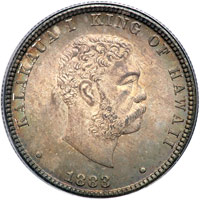 |
1883 Hawaiian Quarter Dollar. PCGS graded MS-65 CAC Approved. In a new secure plus holder. Pop 158; 102 finer. Nicely toned and boldly struck. For those who appreciate a toned specimen, we encourage bids on this attractive Gem MS65 quarter dollar (PCGS # 10987) .
Estimated Value $500 - 550.
The Forsythe Collection.
View details and enlarged photos
Check results on similar lots
| Unsold |
Lot 1837 |
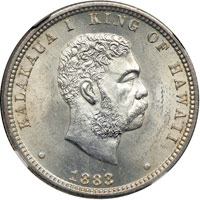 |
1883 Hawaiian Quarter Dollar. NGC graded MS-65. A nice untoned example. This lovely Gem is finished in satin luster with glowing fields. Bidders will notice the sharply impressed devices. As is sometimes seen (but not here, fortunately), the imprint that was left by the dies lacks a certain sharpness on the highest obverse points, mainly Kalakaua�s sideburn and beard, but this coin stands apart for this date. It has a wonderful clear delineated strike (PCGS # 10987) .
Estimated Value $500 - 550.
The Forsythe Collection.
View details and enlarged photos
Check results on similar lots
| Unsold |
Lot 1838 |
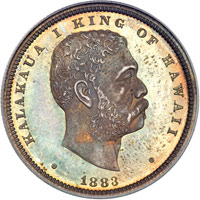 |
1883 Hawaiian Half Dollar. PCGS graded Proof 66 CAC Approved. In a new secure plus holder. Pop 1; none finer at PCGS. Probably the finest known. This Proof 66 Hawaiian Half Dollar is as close to perfect as anyone could ask in such a coin, and is unquestionably the finest Proof half dollar of the series that we have ever seen. It is fully struck with a sharp square edge and deep mirror fields that are immaculate and pristine. The few lines present in the fields indistinguishable from faint planchet lines similar to those caused by the minting process. The toning is as lovely and perfect as the technical quality of the surfaces, a near superb pale to medium multicolored iridescent blend of blue and gold, which are the predominant colors, and pastel pinkish or lilac. Every letter is boldly defined with all of its square-edged certainty, while the head and shield are extremely sharp. All of the shield�s central motifs and escutcheon are also fully struck."
We would note that the mildly frosted motifs stand out against the mirrored fields at all angles, but especially when the coin is tilted under a light source. We would also mention that the toning dominates all areas of both sides. This patina gives it aesthetic appeal above and beyond. The surfaces fit squarely within the strict parameters for the Proof 66 designation, with an entire absence of pedigree markers on either side outside of the color.
The present nearly superb Proof is a forceful reminder to everyone who collects Hawaiian coins that it is quality that matters. Mr. Forsythe is releasing his carefully assembled collection into the marketplace. Bidders may never again have this opportunity to choose from among the top pieces in existence! (PCGS # 10993) .
Estimated Value $25,000 - 30,000.
The Forsythe Collection.
View details and enlarged photos
Check results on similar lots
| Realized
$43,700 |
Lot 1839 |
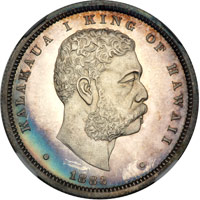 |
1883 Hawaiian Half Dollar. NGC graded Proof 65 Cameo. CAC Approved. Among the finest known. A breathtaking Gem that the viewer will discover boasts magnificent cameo frost on the devices, devices with delicately frosted, precisely detailed relief and surrounded by gorgeous deep liquid-reflective fields. The obverse is accented by a splash of wonderful cobalt blue, rich with iridescence. Along the lower obverse rim the toning starts converging into a blush of the most delicate gold and lavender including warm gold as well on the reverse. More toning is noted at the Hawaiian denomination HAPALUA on the immaculate, fully gleaming reverse. (The Hawaiian word Hapalua means quite literally, "half [of] two" or, more or less the same thing, "the fraction ½," which also appears in the field left of the shield.)
The Proof mintage of 26 pieces assures this denomination its place in the roster of rarities. This denomination is also the second most difficult Hawaiian coin to obtain as a business strike, adding significantly to its general appeal among seekers of the finest in Hawaiian coinage.
According to the Stack�s research from 2008, "Consulting the Dannreuther-Garrett auction record reveals that Proof-61 and Proof-63 are the highest grades appearing at public auction in recent times. Providing additional insight into this Gem Proof's exceptional rarity is the knowledge that this is the finest graded by NGC and that PCGS has certified no half dollar in Proof-65 and only one in Proof-66, the highest grade assigned. Investigation is likely to prove that this splendid full Gem approaches the pinnacle in any list of finest known pieces."
(Once part of a five-piece 1883 Hawaiian silver Proof set that appears to have been kept intact since the time of striking until recent times.) Pop 1; none finer at NGC .
Note: The Hawaiian motto appears on the reverse of all five silver denominations struck for Kalakaua. It was adopted by the Kingdom of Hawaii in 1843 and was used in an address by King Kamehameha III at ceremonies following the return of his kingdom from the British. British captain Lord George Paulet of the HMS Carysfort demanded that Hawaii was ceded to Great Britain in response to claims of political abuses against British residents made by British Consul Richard Charlton. After Kamehameha III sent word to London of the captain's undiplomatic actions, Admiral Richard Darton Thomas returned sovereignty back to the King. The motto is also featured in Israel Kamakawiwo'ole's song "Hawaii '78" and is used on the Hawaii state quarter.
Estimated Value $22,000 - 25,000.
The Forsythe Collection; earlier from Stack's 11/2008 sale.
View details and enlarged photos
| Realized
$39,100 |
Lot 1840 |
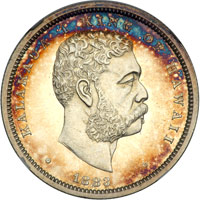 |
1883 Hawaiian Half Dollar. NGC graded Proof 63+ Cameo CAC Approved. Nice blue and gold toning around the edges of both sides. Attractive surfaces and sharp detail including all areas up to and including the edges. Only 26 struck in Proof. This select coin's mirror field is subtly favored by nuances of color which makes for a concerto of beauty and powerful visual appeal. What's more, the coin's very small mintage and low survival rate are keys to its rarity, as is the finding that Proof 63+ cameos are within hailing distance of the few pieces graded higher. Fully original -- an important and rare feature for this sometimes cleaned and overly abused issue -- the devices display razor-edged detail whose pitapatation is almost unnerving to view against the mirror fields. Magnification brings everything out boldly. Proofs are from specially prepared Proof dies installed in the Mint's hydraulic press, the same press used for striking Mint medals in high relief and other elite items. An indispensable purchase for the advanced buyer of rare Hawaiian coins. Pop 3; 1 finer in 65.
Estimated Value $15,000 - 16,000.
View details and enlarged photos
| Realized
$26,450 |
Lot 1841 |
 |
1883 Hawaiian Half Dollar. NGC graded Proof 63 Cameo CAC Approved. A hint of light gold tone. Only 26 Proofs struck. One of several lovely cameo Proof Hawaiian coins consigned to us, this piece has all the charm and beauty one comes to expect of U.S. Mint-made Proofs of the 1880s. The extremely low Proof mintage leads to only a handful of survivors which always excite bidders when they appear in auction. Besides unqualified technical condition, this coin's desirability is enhanced by beautiful strong cameo effect between the frosted devices and mirror-deep field. At the same time that the luster blossoms, substantial detail reveals itself on the highpoints of this exceptional example. All in all a remarkable coin! Pop 3; 1 finer in 65.
Estimated Value $14,000 - 15,000.
The Forsythe Collection.
View details and enlarged photos
| Realized
$23,000 |
Lot 1842 |
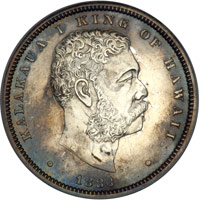 |
1883 Hawaiian Half Dollar. PCGS graded Proof 63. In a new secure plus holder. Pop 3; 1 finer in 66. Irregular toning on both sides. Some minor obverse marks. This rare coin�s reflective field is subtly favored by hazy toning of a typical antique-silver hue that makes this example a concerto of originality, sharp detail, and strong visual appeal. What's more, the coin's very small mintage of 26 and low surviving population are keys to its rarity, as is the finding that Proof 63 cameos are within hailing distance of the few pieces graded higher. Fully original -- an important and rare feature for this sometimes cleaned or hairlined issue. No more than the luster and toning comes a desirable strike. This piece is struck with scientific exactness throughout the devices typical of the Proof issue, from the specially prepared Proof dies installed in the Philadelphia Mint's hydraulic press used to strike U.S. Seated Liberty coins of the period and other denominations. An indispensable purchase for the advanced buyer of rare Hawaiian coins (PCGS # 10993) .
Historic note: The Philadelphia Mint struck Hawaiian Proofs in two batches. Six silver Proof sets without the eighth dollar were struck in September 1883. A year later 20 sets with the eighth dollar (5-coin set) were struck in silver Proof. (Eighteen of the sets were struck in 4 denominations, the eighth, quarter, half and one-dollar in pattern copper pieces, identical to the silver and struck from the same dies. Some of these equally rare Patterns are also being offered in the Forsythe Collection.).
Estimated Value $13,000 - 14,000.
The Forsythe Collection.
View details and enlarged photos
Check results on similar lots
| Realized
$18,400 |
Lot 1843 |
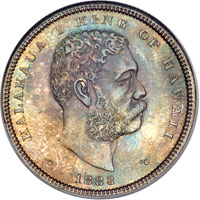 |
1883 Hawaiian Half Dollar. PCGS graded MS-65+ CAC Approved. In a new secure plus holder. Pop 1; 1 finer in 66. Nice blue and gold toning. We are about to describe the luster, but first we�d like to say a word or two about the outstanding detail of this piece, we point to it being a strongly struck coin, with nice devices from top to bottom including the important high points. Compared to some others that are offered in times past, the difference here shows incredible "striking detail." Clearly the second most visually arresting aspect of this coin aside from the strike is its wonderful mint luster. Full spinning luster on both sides, in fact, associated with delightful original toning. A great combination. A frosty, well struck Gem (PCGS # 10991) .
Estimated Value $3,000 - 3,500.
The Forsythe Collection.
View details and enlarged photos
Check results on similar lots
| Realized
$8,913 |
Lot 1844 |
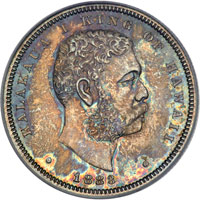 |
1883 Hawaiian Half Dollar. PCGS graded MS-65 CAC Approved. In a new secure plus holder. Pop 12; 2 finer, 1 in 65+, 1 in 66. Attractively toned on both sides. All this is perhaps par for the course given the grade, the source of the consignment, and the extreme care PCGS takes when grading coins of this caliber. Anything negative would immediately remove it from the assigned grade of MS65. We should also like to point out an especially bold strike complementing the luster. Shimmering mint frostiness underpins the color as it covers the fields from side to side of this handsome Gem. One might almost say that a splendid spirit of confidence animates this Hawaiian half dollar. For it is plainly unum in paucis (one among the few)! (PCGS # 10991) .
Estimated Value $2,800 - 3,000.
The Forsythe Collection.
View details and enlarged photos
Check results on similar lots
| Realized
$7,763 |
Lot 1845 |
 |
1883 Hawaiian Half Dollar. PCGS graded MS-65 CAC Approved. In a new secure plus holder. Pop 12; 2 finer, 1 in 65+, 1 in 66. Nicely toned and well struck. A high degree of luster spins smoothly on the satin, deep toned surfaces of this fresh and elusive gem. The strike is crisp in the key areas, with substantial detail noted at the centers (PCGS # 10991) .
Estimated Value $2,800 - 3,000.
The Forsythe Collection.
View details and enlarged photos
Check results on similar lots
| Realized
$7,763 |
Lot 1846 |
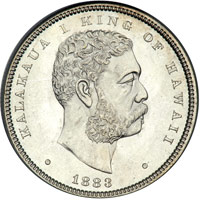 |
1883 Hawaiian Half Dollar. PCGS graded MS-64+ CAC Approved. In a new secure plus holder. Pop 3; 14 finer, 12 in 65, 1 in 65+, 1 in 66. Fully white example, the surfaces range from silvery to hard white frost. A lustrous and nicely struck MS64 with much better eye appeal than usual for even this desirable grade. Far in advance of most, this was struck with systematic exactness including (not excepting) the intermittent weak areas in the centers (PCGS # 10991) .
Estimated Value $2,500 - 2,700.
The Forsythe Collection.
View details and enlarged photos
Check results on similar lots
| Realized
$5,175 |
Lot 1847 |
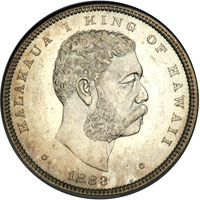 |
1883 Hawaiian Half Dollar. PCGS graded MS-64 CAC Approved. In a new secure plus holder. Pop 55; 17 finer. Mostly untoned. A frosty specimen with inklings of a higher grade. The lustrous surface displays eruptions of silvery freshness throughout with faint shades of toning on both sides. Just as fully struck as others in the sale, there is never a hint of limitation in the detail at the beard and mustache, the shield central escutcheon (the latter of which often suffers when the dies do not impart the proper amount of force against the planchet). All in all a handsome offering (PCGS # 10991) .
Estimated Value $2,400 - 2,600.
The Forsythe Collection.
View details and enlarged photos
Check results on similar lots
| Realized
$4,485 |
Lot 1848 |
 |
1883 Hawaiian Half Dollar. PCGS graded MS-63 CAC Approved. In a new secure plus holder. Pop 61; 74 finer. Mostly untoned with semi-reflective fields. As is the case with other coins acquired by Mr. Forsythe when assembling his Hawaiian collection, this half dollar seems to be hand-picked from the available supply with attention given to its overall choiceness and sharp detail in the strike. The new owner will gain hours of pleasure examining the intricate design in Kalakaua�s portrait as well as gain a better understanding of the nature of Monarchical government through the symbolism of the shield reverse, which uses the central motif from the Hawaiian Coat of Arms.
In the center of the seal is a heraldic shield which is quartered. The first and fourth quarters display the white, red, and blue stripes of Ka Hae Hawaii or the flag of Hawaii. The second and third quarters are on a yellow field with a white Puloulou, or tabu ball, pierced on a black staff. In the center of the heraldic shield (but modified slightly on the coin) is a green escutcheon with a five-pointed yellow star in the center (PCGS # 10991) .
Estimated Value $1,400 - 1,500.
The Forsythe Collection.
View details and enlarged photos
Check results on similar lots
| Realized
$2,875 |
Lot 1849 |
 |
1883 Hawaiian Half Dollar. PCGS graded MS-63 CAC Approved. In a new secure plus holder. Pop 61; 74 finer. A nice untoned example. Powerfully burning luster shines forth on the satiny, brilliant surfaces of this Choice coin. No toning or haze obscures the viewer�s enjoyment of the silvery sheen, with comparable sharpness to the portrait and coat of arms to signify that this is an above average specimen, no doubt hand picked by the consignor from among the competition for its desirable qualities (PCGS # 10991) .
Estimated Value $1,400 - 1,500.
The Forsythe Collection.
View details and enlarged photos
Check results on similar lots
| Unsold |
Lot 1850 |
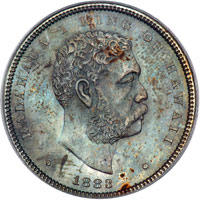 |
1883 Hawaiian Half Dollar. PCGS graded MS-63. In a new secure plus holder. Pop 61; 74 finer. Evenly toned on both sides, well struck and lustrous. Although there were 700,000 half dollars minted ($350,000 face amount), many were melted. Records shows that 612,245 were redeemed and so melted. On January 14, 1903 President Theodore Roosevelt approved an act of Congress providing for redemption of the Hawaiian silver coins at par with U.S. coins. The Kalakaua coins were not legal tender after January 1, 1904. It is estimated by Medcalf "that no more than $200,000 remained outstanding from the original mintage of $1,000,000." This high melt rate explains the rarity of the dime, half dollar, and silver dollar in choice Mint condition (PCGS # 10991) .
Estimated Value $1,400 - 1,500.
The Forsythe Collection.
View details and enlarged photos
Check results on similar lots
| Unsold |
Lot 1851 |
 |
1883 Hawaiian Dollar. NGC graded Proof 65+Cameo CAC Approved. The finest known Hawaiian proof dollar. This amazing coin's beautifully frosted deep cameo devices seem to float on the essentially flawless deep liquid-mirror fields. Put on a pair of those funny 3D glasses that movie-goers wear and we fancy you�ll see so much dimensional depth that the designs will appear to be jumping out into space at you! A few subtle hairlines are seen in the obverse field, but these are essentially trivial where the generally magnificent eye appeal is concerned. The gleaming silver fields subtly contrast with a hint of pale gold that follows the denticles and the sharply defined outer rims. One of 26 Proofs struck at the San Francisco Mint.
The broad diameter of the dollar allowed Engraver Charles E. Barber to place the complete royal emblem and supporters on an elaborate mantle on this reverse, flanked by the abbreviated denomination 1 - D. The full Hawaiian denomination AKAHI DALA follows the lower rim. This denomination was affected by the early growth of world Crown collecting in the 1960s which focused the attentions of a wide variety of collectors on dollar-sized pieces. The wholesale destruction of 453,652 of the 500,000 business strikes and the damage inflicted on many survivors through jewelry fabrication certainly helped direct avid attention toward the small Proof population. The subsequent sky-rocketing interest in Hawaiiana has propelled the interest in such pieces to ever greater heights.
Only a few Proof dollars have appeared at public auction in the recent past, several of them repeat offerings, with, according to the now out-of-date Dannreuther-Garrett compendium of auction records, none graded higher than Proof-63. This specimen is by far the finest certified by NGC. PCGS has certified one dollar as Proof-65, its highest grade with none finer. It is perfectly possible that the present glittering Proof is the finest known or at the very least a mere whisper from the finest.
(Originally part of a five-piece 1883 Hawaiian silver Proof set that appears to have been kept intact since the time of striking. The other coins from this set are offered singly in the Gerald Forsythe consignment.) Pop 1; none finer at NGC.
Estimated Value $40,000 - 50,000.
The Forsythe Collection.
View details and enlarged photos
| Realized
$89,125 |
Lot 1852 |
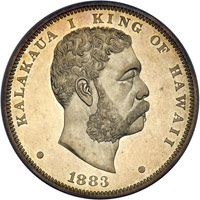 |
1883 Hawaiian Dollar. PCGS graded Proof 64 Cameo CAC Approved. In a new secure plus holder. A hint of light tone. A clearly superior example to the few others offered. This strikingly beautiful coin is one of the finest ever graded, and a pure joy to hold and study. Bidders who view it at lot viewing will no doubt admire it lovingly under illumination to watch the play of glinting mirror surface mingling with the delicate color. Further to its benefit, a penetrating strike delivers uniformly bold detail on the main features. Each side exhibits conspicuous field-to-motif contrast, indeed, lovely cameo contrast. This is especially prevalent when the coin is tilted under a light. As might be expected for the Proof 64 Cameo designation, the surfaces are nearly impeccable in their preservation.
On the left of the coat of arms is the numeral 1, and on the right D, wihile underneath AKAHI DALA, both meaning, "one dollar." At the bottom of the shield is the cross of an Order instituted by Kalakaua. The obverse of the smaller coins is the same with that just described. However, due to space limitations, they have on their reverse, the arms without the mantle, etc. We would be hard pressed to locate pedigree identifiers for future catalogers and researchers. Pop 1; none finer at PCGS In Cameo Proof. (PCGS #415929).
The motto is, 'Ua mau ke ea o ka aina i ka pono.' The life of the land is perpetuated by righteousness. It refers to the speech of the King at the time of cession, Feb. 25, 1843. 'I have given away the life of the land. I have hope that the life of the land will be restored when my conduct is justified.' It very naturally alludes to the righteousness of the British government, in returning the Island to their legal sovereign, to the righteousness of the Hawaiian which secured the restoration, and to the general principle, that it is only by righteousness that national existence is preserved, explains the American Journal of Numismatics for October 1883, in a lengthy, detailed piece on the then-new Hawaiian coinage.
Estimated Value $25,000 - 30,000.
The Forsythe Collection.
View details and enlarged photos
| Realized
$48,300 |
|
|